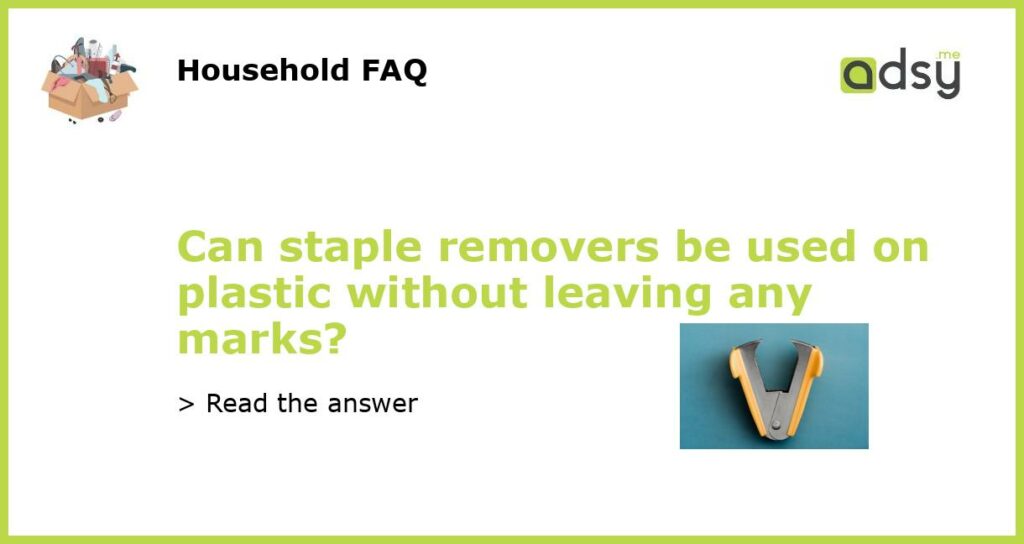Can staple removers be used on plastic without leaving any marks?
Introduction to staple removers and plastic
Staple removers are essential tools for removing staples from various materials, including papers, fabrics, and cardboard. However, when it comes to removing staples from plastic, concerns arise about potential damage or marks left behind. Plastic surfaces are more susceptible to scratches and scuffs, making it important to handle them with care. In this article, we will explore whether staple removers can be used on plastic without leaving any marks.
Types of staple removers and their suitability for plastic
There are different types of staple removers available in the market, including jaw-style, claw-style, and mini-staple removers. The suitability of these staple removers for plastic largely depends on their design and the material they are made of.
Jaw-style staple removers, also known as plier-style, feature two jaws that grip the staple from both sides for easy removal. These staple removers are typically made of metal and may not be ideal for use on plastic surfaces. The metal jaws can cause scratches or indentations on the plastic, leaving undesirable marks.
Claw-style staple removers, on the other hand, have a single curved claw that slides underneath the staple and lifts it out. These staple removers are often made of plastic or a combination of plastic and metal. Plastic claw-style staple removers are generally safer to use on plastic surfaces as the risk of leaving marks is minimized.
Mini-staple removers are compact tools designed specifically for removing small staples. These staplers often have a plastic body and a metal tip. While they may be suitable for removing staples from plastic, caution should still be exercised to avoid any potential damage.
Tips for using staple removers on plastic
Although staple removers can be used on plastic without leaving marks, it is essential to take certain precautions to minimize any potential damage. Here are some tips for using staple removers on plastic:
- Choose a claw-style staple remover with a plastic claw: To reduce the risk of marks on plastic, opt for a staple remover with a plastic claw. Metal claws have a higher chance of causing scratches or dents.
- Gently insert the tip of the remover under the staple: Carefully slide the claw under the staple, making sure not to apply excessive force or pressure. This will help minimize any potential damage to the plastic surface.
- Lift the staple slowly and evenly: Once the claw is positioned under the staple, lift it out slowly and evenly. Avoid jerky movements or tugging, as this can lead to marks or indentations.
- Test on a small inconspicuous area: Before using a staple remover on a visible area of the plastic, test it on a small, inconspicuous area to ensure it doesn’t leave any marks or scratches.
- Clean the surface afterward: After removing the staple, gently clean the plastic surface to remove any residue or marks left by the staple remover. This can be done using a damp cloth or plastic-safe cleaner.
Alternatives to staple removers for removing staples from plastic
If you are concerned about using staple removers directly on plastic, there are alternative methods you can try to safely remove staples without leaving marks. These include:
- Using your fingers: For small and shallow staples, gently pry them up using your fingers. Ensure your nails are short to avoid inadvertently scratching the plastic surface.
- Using a plastic tool: Plastic tools, such as a credit card or a plastic letter opener, can be used to lift the staple edges and remove them from the plastic surface. These tools are less likely to cause damage compared to metal staple removers.
- Heating the staple: In some cases, gently heating the staple using a hairdryer for a few seconds can help soften the plastic around it. This makes it easier to lift the staple without leaving any marks. Use caution when applying heat to plastic.
Conclusion
Staple removers can be used on plastic surfaces if used with caution. By choosing the right type of staple remover, handling it carefully, and following the tips mentioned above, you can minimize the risk of leaving marks on plastic. Additionally, alternative methods like using your fingers or plastic tools can also be effective in removing staples from plastic without causing damage. Remember to always test on a small inconspicuous area and clean the surface afterward to ensure a pristine finish.






